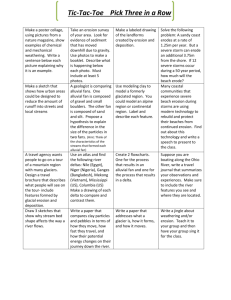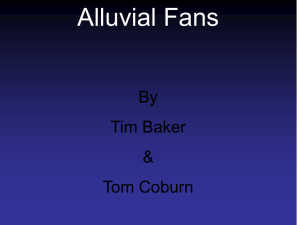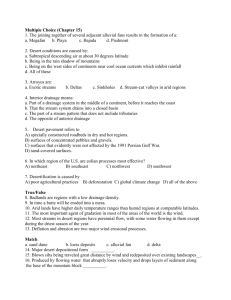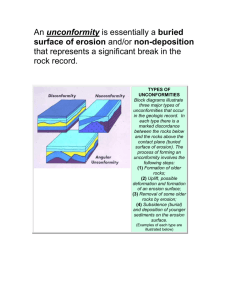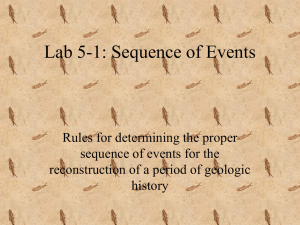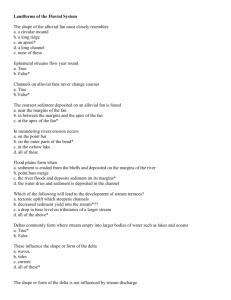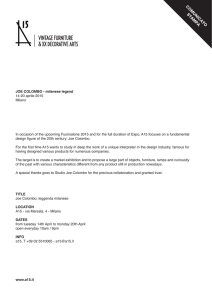Appendix 15. Possible Confusion in Identifying
advertisement
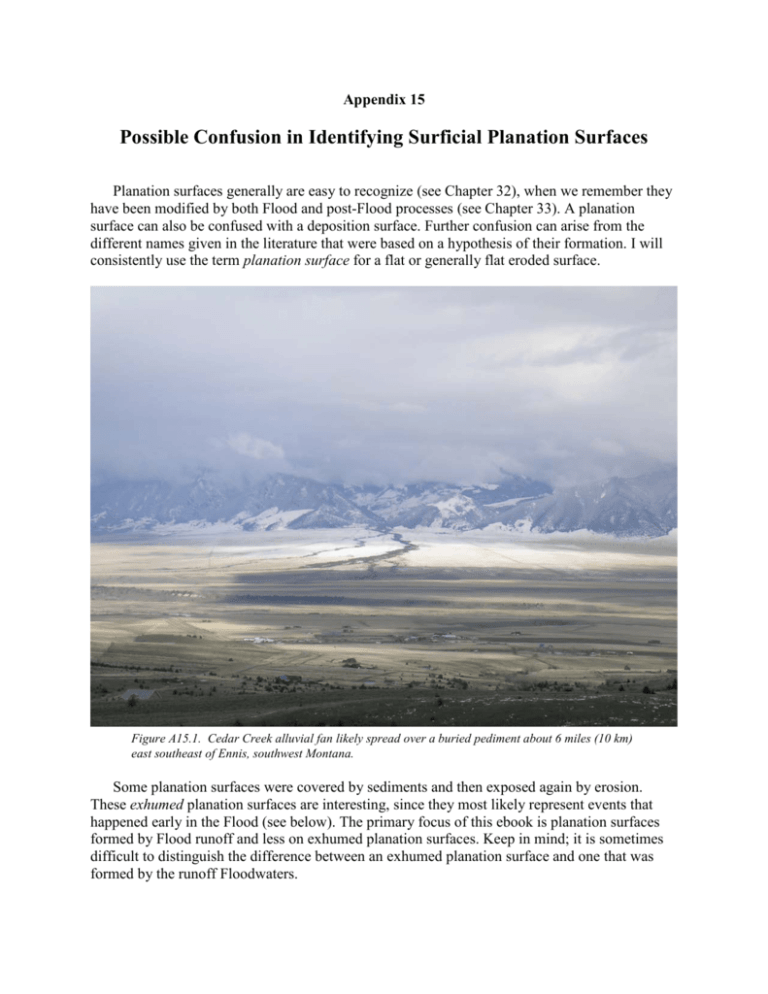
Appendix 15 Possible Confusion in Identifying Surficial Planation Surfaces Planation surfaces generally are easy to recognize (see Chapter 32), when we remember they have been modified by both Flood and post-Flood processes (see Chapter 33). A planation surface can also be confused with a deposition surface. Further confusion can arise from the different names given in the literature that were based on a hypothesis of their formation. I will consistently use the term planation surface for a flat or generally flat eroded surface. Figure A15.1. Cedar Creek alluvial fan likely spread over a buried pediment about 6 miles (10 km) east southeast of Ennis, southwest Montana. Some planation surfaces were covered by sediments and then exposed again by erosion. These exhumed planation surfaces are interesting, since they most likely represent events that happened early in the Flood (see below). The primary focus of this ebook is planation surfaces formed by Flood runoff and less on exhumed planation surfaces. Keep in mind; it is sometimes difficult to distinguish the difference between an exhumed planation surface and one that was formed by the runoff Floodwaters. Depositional Surfaces Since a planation surface is often capped by a veneer of mostly rounded cobbles and boulders, it may be difficult to distinguish it from a depositional surface, such as a flood plain, river bar, river terrace, or alluvial fan, without subsurface information. An alluvial fan is: A low, outspread, relatively flat to gently sloping mass of loose rock material, shaped like an open fan or a segment of a cone, deposited by a stream (esp. in a semiarid region) at the place where it issues from a narrow mountain valley upon a plain or broad valley… 1 Figure A15.1 shows the Cedar Creek alluvial fan in the Madison Valley southeast of Ennis, Montana. Alluvium is a general term for deposits laid down by streams or rivers, especially during flooding. When several alluvial fans, issuing from adjacent streams flowing from valleys of a mountain range, converge, the depositional surface is called a bajada (Figure A15.2). A Figure A15.2. A bajada from Death Valley, California. bajada is defined as a broad, gently-inclined depositional surface extending from the base of a mountain range out into a valley or basin and formed by the lateral coalescence of a series of alluvial fans. 2 So, it is possible to confuse a planation surface with an alluvial fan or bajada, or 1 Neuendorf, K.K.E., J.P. Mehl, Jr., and J.A. Jackson, 2005. Glossary of Geology, Fifth Edition. American Geological Institute, Alexandria, Virginia, p. 17. 2 Neuendorf et al., Ref. 1, p. 50. even the top of a debris flow that has come to rest. A debris flow is a moving mass of rock fragments, soil, and mud where more than half of the particles are larger than sand size. 3 Alluvial fans are often observed at valley or canyon mouths that open up into a larger valley. Often the stream that has deposited the alluvium is braided or anastomosed on the surface of the alluvial fan. A braided steam is: A stream that divides into or follows an interlacing or tangled network of several small branching and reuniting shallow channels separated from each other by ephemeral branch islands or channel bars, resembling in plan [view] the strands of a complex braid. 4 If the areas between are quite large and not part of the stream, the stream is referred to as an anastomosing stream. Both types represent an underfit stream, or a stream that is reduced from a peak in the past (see Chapter 62 of Volume III on underfit streams). Besides stream deposition, debris flows also deposit on top of alluvial fans. 5,6 They typically follow channels and result in matrix-supported gravel, gravel in which the rocks, called clasts, are mostly separated by finer-grained sediments. Clast-supported gravel is gravel in which the rocks are mostly touching each other, and these are generally laid down by streams. Matrixsupported gravel is gravel in which the large rocks are not or rarely touching each other and are separated by finer-grained sediments. Matrix-supported gravel is typical of glacier debris or mass flows. Thus, the gravel in an alluvial fan can be either rounded by water action or angular from debris flow deposition, and the clasts can be either clast or matrix supported. Furthermore, the gravel deposited in an alluvial fan is often separated by fine-grained sediment, such as silt or sand. So, the gravel deposits in an alluvial fan are generally chaotic. A pediment is a planation surface at the base of a mountain range or ridge (see volume III on the subject of pediments). Sometimes, the top of an alluvial fan or debris flow can cover a pediment causing confusion on the identification of a pediment. Using subsurface data, Williams discovered that researchers of the Colorado Plateau have often mistaken the tops of debris flow deposits for pediments with a veneer of alluvium.5 It is likely that the alluvial fan in figure A15.1 covers a pediment. Terminology Problems Planation surfaces have been given many names in the literature, usually related to a particular hypothesis for their formation (see part X). In Davis’s “cycle of erosion,” the final stage is called a “peneplain.” A peneplain is defined as: A term introduced by Davis (1889, p. 430) for a low, nearly featureless, gently undulating land surface of considerable area, which presumably has been produced by the processes of long-continued subaerial erosion… 7 References to peneplains were quite common in the literature of the early- and mid-twentieth century, and sometimes even used today. Regardless of Davis’s hypothesis (discussed in Chapter 50), a peneplain is a rolling erosion surface, but not a planation surface; peneplain means “nearly a plain.” The formation of a flat surface supposedly would take much more time than the 3 Neuendorf et al., Ref. 1, p. 165–166. Neuendorf et al., Ref. 1, p. 81–82. 5 Williams, V.S., 1984. Pedimentation versus debris-flow origin of plateau-side desert terraces in southern Utah. The Journal of Geology 92:457–468. 6 Rust, B.R. and E.H. Koster, 1984. Coarse alluvial deposits. In, Walker, R.G. (editor), Facies Models, second edition, Geoscience Canada, Reprint Series 1, Geological Association of Canada, St Johns, Newfoundland, pp. 53– 69. 7 Neuendorf et al., Ref. 1, p. 479. 4 formation of a rolling erosion surface from a mountainous area according to the uniformitarian paradigm. Other terms for large-scale erosion surfaces are “pediplain,” “panplain,” and “etchplain.” These obsolete terms are discussed in Appendix 19. Since all these terms are specific to certain hypotheses for the origin of erosion or planation surfaces, I will not use them, but will use the general descriptive term planation surface which is not related to any specific postulated mechanism for their formation. Figure A15.3. An angular unconformity at Siccar Point, Scotland, in which gently sloping Old Red Sandstone layers cap a vertically bedded sandstone rocks (wikipedia). This area was made famous by James Hutton in the late 1700s in his defense of uniformitarianism. Exhumed Planation Surfaces Planation surfaces can also exist within a rock sequence. They can be recognized by an angular unconformity, in which the lower rock is tilted and truncated and the upper strata are deposited on the planation surface (Figure A15.3). The lower rock can be an igneous, metamorphic, or sedimentary rock. The Great Unconformity between eastward-dipping Precambrian sedimentary rocks and the Cambrian Tapeats Sandstone in the eastern Grand Canyon (Figure A15.4, top arrow) is a good example of a planation or erosion surface that lies within sedimentary rocks. 8 There is also another unconformity or planation surface in the Grand Canyon between the Precambrian sedimentary rocks and the igneous and metamorphic rocks below (Figure A15.4, bottom arrow). However, this book only discusses planation surfaces that are on the earth’s surface, in other words geomorphological features. Figure A15.4. The Great Unconformity (upper arrow) and a second unconformity between sedimentary and igneous/metamorphic rock (lower arrow) in the eastern Grand Canyon (view north). There are situations, however, when the rock on top of a buried planation surface is eroded, re-exposing the surface. This is called an exhumed planation surface. If all the flat lying strata on top of the Great Unconformity (Figure A15.4) were eroded, it would be an exhumed planation surface. Exhumed surfaces can be recognized when a remnant of sedimentary rocks lies on top of the surficial planation surface. The Canadian Shield of southeast and south-central Canada is considered an exhumed erosion surface due to the presence, in places, of “Paleozoic” carbonate rocks on top of the igneous and metamorphic rocks. 9 The erosion surface of the Canadian Shield continues right under the sedimentary rocks. Exhumed planation or erosion surfaces are 8 Austin, S.A., 1994. Interpreting strata of Grand Canyon. In, Austin, S.A. (editor), Grand Canyon: Monument to Catastrophe, Institute for Creation Research, Dallas, TX, pp. 45–47. 9 Shilts, W.W., J.M. Aylsworth, C.A. Kaszycki, and R.A. Klassen, 1987. Canadian Shield. In, Graf, W.L. (editor), Geomorphic Systems of North America, Centennial Special Volume 2, Geological Society of America, Boulder, CO, pp. 119–161. technically surficial and are interesting in themselves, but will be little discussed in this book because they relate mainly to the early Flood. However, it may be difficult in places to distinguish between a surficial planation surface and an exhumed planation surface. Figure A15.5. The unconformity between the Muav and Redwall Limestones (the point at which the green limestone change upward to the red limestone) in the Grand Canyon along the North Kaibab Trail. Another problem arises when uniformitarian scientists claim a planation surfaces within parallel sedimentary rocks when the evidence is questionable. For example, a planation surface can be invoked at a bedding plane where the contact supposedly represents a gap in time. Sometimes, there really is no way of knowing whether erosion has really occurred, or whether the amount of erosion is large, especially when the gap in time, a hiatus, is based only on fossils of different supposed ages within the evolutionary timescale. Such an alleged erosion or planation surface is usually called a paraconformity, which is defined as an obscure or uncertain unconformity in which the contact is a simple bedding plane between parallel strata. 10 When beds are conformable at the “hiatus,” or supposed time break, it is doubtful that the contact represents a planation surface. Paraconformities are quite common in secular geology, as likely with the gap of about 160 million years between the Muav Limestone and the Redwall Limestone in the Grand Canyon (Figure A15.5). 10 Neuendorf et al., Ref. 1, p. 469.

